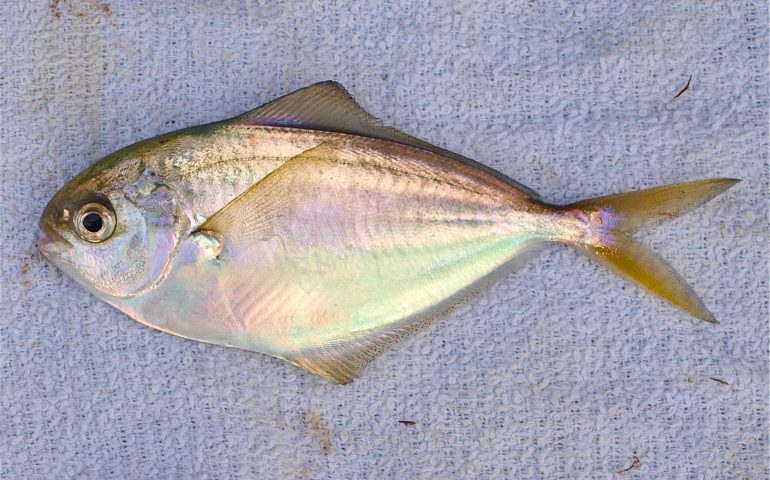Species: Peprilus simillimus (Ayres, 1860); from the Greek word pepricos (one of Hesychian’s unknown fish) and the Latin word simillimus (very similar, in reference to a similar Atlantic butterfish).
Alternate Names: Pompano, California pompano, Pacific pompano and dollarfish. Called palometa plateada in Mexico.
Identification: A very deep compressed body with a somewhat perch shape. Butterfish have very long dorsal and anal fins and no pelvic fins. Their coloring is metallic silver or blue on the side with a greenish back.
Size: To 14.2 inches; most caught from piers are under 8 inches.
Range: Gulf of California, and the Pacific Coast between Bahia Magdalena, southern Baja California, and Haida Gwaii (formerly Queen Charlotte Islands), northern British Columbia. Common from southern Baja California, to Vancouver Island, British Columbia.
Habitat: Typically in sandy nearshore areas; found from the surf zone to a recorded depth of 991 feet.
Piers: An occasional catch at sandy-shore piers in southern California; less common but still caught at a few piers north to San Francisco. I have caught more at the Ocean Beach Pier, Seal Beach Pier and Belmont Veterans Memorial Pier than at any other piers. Best bets: Imperial Beach Pier, Ocean Beach Pier, Crystal Pier, Oceanside Pier, San Clemente Pier, Balboa Pier, Newport Pier, Huntington Beach Pier, Seal Beach Pier, Belmont Veterans Memorial Pier, Hermosa Beach Pier, Manhattan Beach Pier, Venice Pier, Malibu Pier, Ventura Pier, Pismo Beach Pier, Cayucos Pier, San Simeon Pier, and Pacifica Pier.
Shoreline: An infrequent catch by sandy shore anglers in southern California.
Boats: An inshore species rarely take from boats.
Bait and Tackle: Usually caught on small hooks, size 8 or 6, and small strips of anchovy (although the fish can be finicky and at time will be more attracted by small pieces of fresh mussels or shrimp). A high/low leader works fine, and these fish often like to hit mid-depth similar to silver surfperch.
Food Value: A flavorful, good eating fish with small flakes, and soft texture. It has moderate to high fat content in the flesh, hence its name. Best pan-fried whole but only the largest fish seem to have enough meat to make it worth the effort. However, it was long regarded as one of the best “eating” fish in the state, in fact one that was considered a “delicacy” that brought a high price.
Food Fishes—Of the small varieties of fish there are the smelt, herring, perch, sardine and pompano, together with quite a number of other varieties. The pompano is the rarest and most expensive fish caught on this coast, the market price being $1 per pound, and the fish is sold readily at that price as soon as put upon the market.—Los Angeles Herald, January 1, 1893
18-Inch Pompano Caught At Laguna — A real find in the shape of a genuine gulf coast pompano, which measured 18 inches from tip to tip, fell to the lot of Oscar Farman of Laguna, who promptly enjoyed a pompano dinner. This is declared to be the largest fish of this variety ever caught along the southern coast. Pompano of five or six inches in length are not unknown, but even those are fairly scarce and few enjoy the distinction of annexing them. In San Francisco, according to Farman, pompano used to “sell” for one dollar ($1.00) a pound.—Santa Ana Register, July 10, 1919
Playa del Rey—Hardly a foot of the wharf was unoccupied by some fisherman casting his line and reaping a harvest from the unusually fine run of pompano. Everybody on the pier joined in the sport, nearly, and good baskets were the result in every instance.—Los Angeles Herald, July 9, 1908
Pompano, the delicious little poppy fish, made Playa del Rey one of the most popular resorts during the week.—Los Angeles Herald, September 28, 1908
Fish and Game Bulletin No. 49 (The Commercial Fish Catch of California for the Year 1935) states “One of the finest food fishes taken in California for the fresh fish markets is the California pompano, which unfortunately is not caught in any great abundance…It is the highest priced market fish in California.”
Today they are far less common and most people have never tasted one of these fine eating panfish. It is recorded that some people like to smoke the fish whole.
Comments: An attractive little fish that often schools together with perch. Very interesting is the relationship between juvenile Pacific butterfish and the black sea nettle (a LARGE jellyfish that can have a bell almost three feet in diameter and tentacles that can reach 25 feet long or more). The jellyfish sometimes appears in large blooms in San Diego Bay and when they do they provide the young butterfish with food and protection. The butterfish feed on the plankton the jellyfish gathers and then, when danger approaches, the butterfish will hide inside the bell of the jellyfish.

wherebcan I buy Wild Pomano fish near Laguna, Newport or Dana point i S Cal? HMart has farmed Golden Pompino prob. from China but I prefer wild. Thanks!
The jellyfish sometimes appears in large blooms in San Diego Bay and when they do they provide the young butterfish with food and protection. The butterfish feed on the plankton the jellyfish gathers and then, when danger approaches, the butterfish will hide inside the bell of the jellyfish.
Escape is not just a game but an endless adventure. Explore smashy road now.